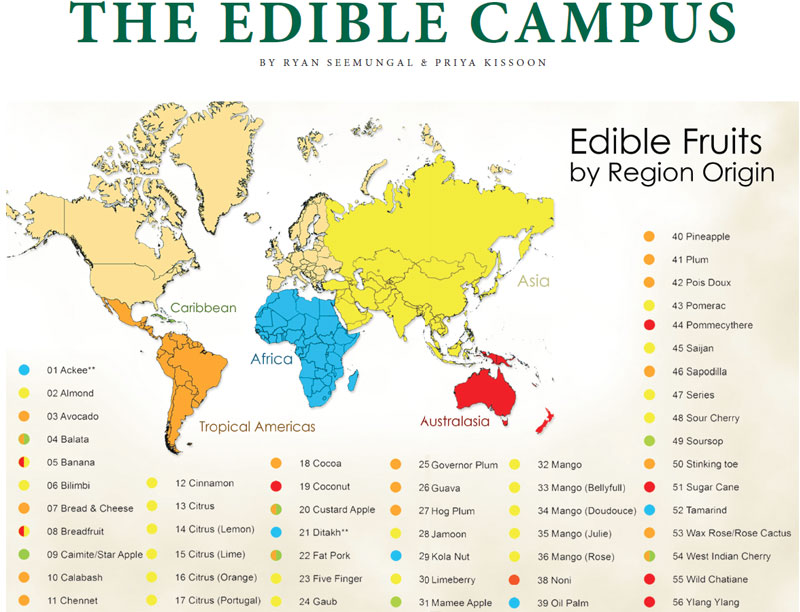|
January 20167

Issue Home >>
|


The trees growing on the grounds of The UWI, St. Augustine Campus have as much significance as its iconic buildings. Yet they are often overlooked and under-valued. In a recent publication by the Department of Geography titled, The Edible Campus, the Dean of the Faculty of Food and Agriculture, Dr Wayne Ganpat, wrote, “Trees are life giving and they are gifts. We must not forget this. They provide oxygen, vital to our very existence and the existence of this planet; they shade us from the hot sun; they add an unmatchable visual and aural aesthetic as they tower over us and the breeze plays with their leaves; and for some trees, their roots, bark, leaves, flowers, and seeds can be medicinal and nutritional.”
The sprawling Samaan trees (Albizia saman) that shade the grounds of the Faculty of Food and Agriculture and Faculty of Engineering have edible seed pods known as “monkey pods” or “cow tamarind” that can be eaten, though they are most often used in animal fodder. The majestic Elephant Ear tree (Enterolobium cyclocarpum), northeast of the Main Administration Building, has edible seeds that have been part of traditional diets in Central and South America from time immemorial.
The Edible Campus project began in 2013 as a series of conversations on campus between Dr Priya Kissoon, John Stollmeyer and Alain Huitdeniers, all of whom are passionate about food sovereignty and environmental sustainability at the margins of modern agriculture. Subsequently, as a part of inquiry-based coursework, students from the Geographies of Food course conducted a campus-wide survey of eating habits, which found that most participants preferred foreign fast food versus local and creole food, they were not aware of most edible trees on campus (for example, chimet/star-apple, carambola/five-finger), and they were also unaware that many trees were edible (example, stinkin’ toe/locust, calabash).
The Geographies of Food course also mapped the readily edible plants on campus (such as, those that could be eaten raw or with little preparation) using Global Positioning Systems (GPS) units to mark coordinates, and then used Geographical Information Systems (GIS) to create full colour cartographic maps of the plant locations in relation to the built environment of the campus.
Students had to learn how to identify edible trees and plants, which is especially difficult when plants are not bearing. Additionally, the rapid development of the campus means that trees are frequently lost to make room for new infrastructure and amenities, which requires updates to the survey and mapping of the campus. Areas off-limits to the general public, such as the Office of the Campus Principal and the grounds of halls of residence, were mapped after receiving special permission from Campus Security and the Office of the Deputy Principal.
The book that resulted from the Edible Campus Project shares descriptions of the campus’ edible plants, their origins, and value-added uses, showcasing students’ research skills and culinary imaginations. Readers of The Edible Campus will find a short history of the UWI-STA campus and the Faculty of Food and Agriculture; full maps of the trees and plants with marked walking routes; an associated pictorial and descriptive guide to each mapped plant; and the results of the social survey of the campus food culture.
Readers are also exposed to the origins of many contemporary “Caribbean” fruit trees and will discover that they may not be Caribbean at all. For example, bananas and coconuts are typically iconographic of the Caribbean; however, neither of these fruits are “local”, because they originate (with some academic debate) from the general Australasia/South-Pacific region. The Division of Facilities Management, National Herbarium, and Alma Jordan Library were vital sources of knowledge for the project. This Project was partially supported by the Campus Research and Publication Fund. The project is ongoing and will be updated on a continuous basis.
Ideally, the project can be replicated in all public spaces to bring food security, famine-foods, environmental awareness, and urban foraging into the popular culture of all citizens.
Copies of the “grazing maps” are free to anyone taking the Edible Campus tour, which can be booked through the Department of Geography. The Edible Campus book is available for purchase from the Department of Geography where all proceeds go to student development, programme enrichment, and outreach activities promoting geographic education. The campus community and visitors are asked to be respectful of the trees on campus. Do not climb, throw objects, or break branches to reach fruit. Pick what you can reach with your fingers, and only what you can eat at the moment. Sustainability requires respect and restraint.

Ryan Seemungal is a graduate student in the Department of Geography which is headed by Dr Priya Kissoon. To request an Edible Campus tour or to purchase a copy of the class project, email: geography@sta.uwi.edu |





